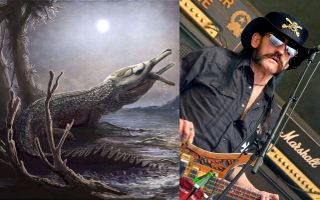'Nastiest' Jurassic Croc Named for Motorhead's Lemmy

Motörhead founder, singer and bassist Ian "Lemmy" Kilmister, who died on Dec. 28, 2015, famously sang, "I don't want to live forever," in the band's signature song, "Ace of Spades." Though Kilmister is gone, scientists have ensured his name will live on — perhaps forever — as part of the scientific name of a species of Jurassic crocodile relative.
Lemmysuchus obtusidens — meaning "Lemmy's blunt-toothed crocodile" — belonged to an extinct group of marine crocs known as teleosaurs. It lived approximately 164 million years ago in coastal waters near what is now Europe, and it measured about 19 feet (6 meters) in length and had a skull that was about 3 feet (1 m) long, according to a description in a new study.
Lemmysuchus had powerful jaws and flattened teeth that could crunch through the shells of its mollusk or turtle prey, and it would have been among the largest coastal predators at the time, study co-author Michela Johnson, a researcher with the School of GeoSciences at the University of Edinburgh in Scotland, said in a statement. [Photos: Ancient Crocodile Relatives Roamed the Amazon]
A near-complete fossil skeleton found in Peterborough, England, in 1909, part of the paleontology collection at the Natural History Museum (NHM) in London, was previously identified as Steneosaurus obtusidens, based on similarities to other known S. obtusidens fossils.
But certain features diverged from S. obtusidens, prompting the scientists to question whether it had been accurately described, and they proposed revisiting its classification, along with that of several other related fossils.
Lemmysuchus diverges most dramatically from its close relatives in the shape of its snout, according to the study. Though its nose was slender compared with that of a modern crocodile, it was shorter and rounder than was typical of teleosaurs from this time in the Jurassic. The nasal surface was "strongly convex," and the snout made up about 62 percent of the overall skull length, the study authors reported.
The study authors determined that the fossil represented a new genus, naming it after Kilmister at the suggestion of study co-author Lorna Steel, a curator at NHM in the earth sciences department, NHM representatives said in the statement.
Sign up for the Live Science daily newsletter now
Get the world’s most fascinating discoveries delivered straight to your inbox.
"We'd like to think that he would have raised a glass to Lemmysuchus, one of the nastiest sea creatures to have ever inhabited the Earth," Steel said.
The findings were published online Aug. 7 in the Zoological Journal of the Linnean Society.
Original article on Live Science.

Mindy Weisberger is an editor at Scholastic and a former Live Science channel editor and senior writer. She has reported on general science, covering climate change, paleontology, biology, and space. Mindy studied film at Columbia University; prior to Live Science she produced, wrote and directed media for the American Museum of Natural History in New York City. Her videos about dinosaurs, astrophysics, biodiversity and evolution appear in museums and science centers worldwide, earning awards such as the CINE Golden Eagle and the Communicator Award of Excellence. Her writing has also appeared in Scientific American, The Washington Post and How It Works Magazine.
